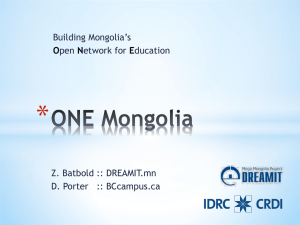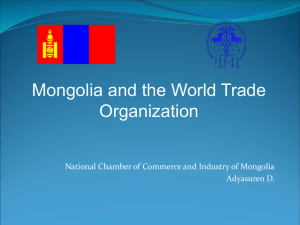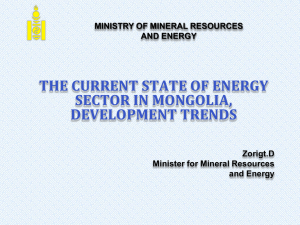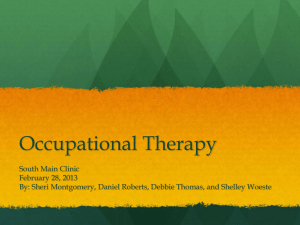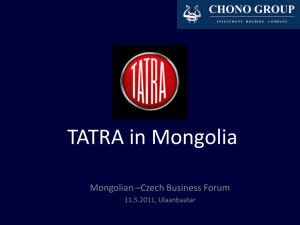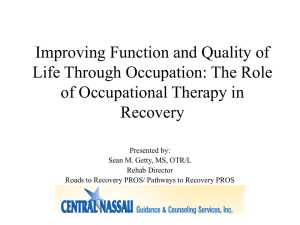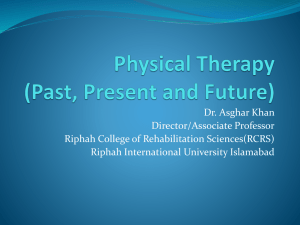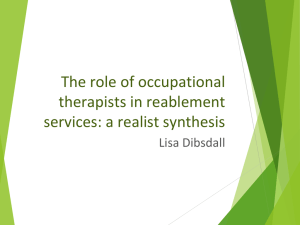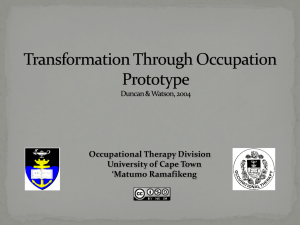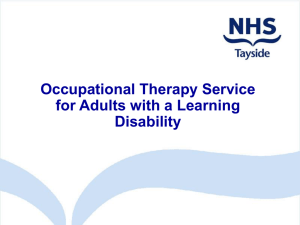Physical and Occupational Therapy in Mongolia
advertisement
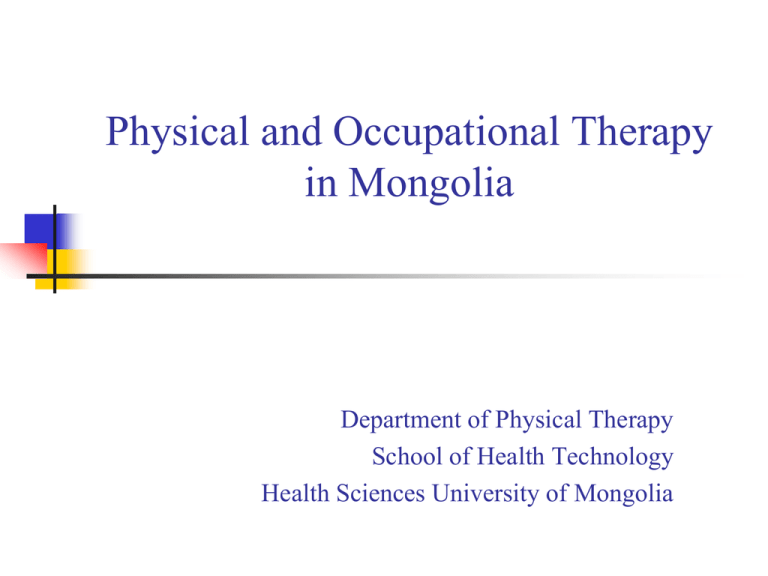
Physical and Occupational Therapy in Mongolia Department of Physical Therapy School of Health Technology Health Sciences University of Mongolia Content Definition of Physical Therapy Definition of Occupational Therapy and its similarity and difference from Physical Therapy History of Physical Therapy in Mongolia Department of Physical Therapy, SHT Academic Exchange Program History of OT in Mongolia OT in Mongolia Project Conclusion Physical therapy is a health care profession concerned with remediation of impairment and disabilities and the promotion of mobility, functional ability, quality of life and movement potential, with prevention of physical disabilities, through examination, evaluation, diagnosis and physical intervention carried out by Physical Therapists. Physical therapy management includes prescription of or assistance with specific exercises, manual therapy, education, manipulation and other interventions. Occupational therapy is a client-centred health profession concerned with promoting health and well being through occupation. World Federation of Occupational Therapists 2010 Occupational therapy Occupational therapists and occupational therapy assistants work with people to improve their ability or restore their ability to perform everyday activities and tasks. Some occupational therapists specialize in work-related tasks, while others offer more generalized services to increase range of motion, reduce the risk of injury, and increase mobility in certain patients. Occupational therapy is "The therapeutic use of work, selfcare, and play activities to increase development and prevent disability. It may include adaptation of task or environment to achieve maximum independence and to enhance the quality of life." The word "occupation" in occupational therapy refers to the daily activities and tasks that an individual performs. Daily activities and tasks include work-related tasks, such as standing, picking up heavy boxes, driving in a car, sitting at a computer, sorting files, moving to a room getting up from a chair. Comparison of OT and PT Occupational therapy and physical therapy seem very similar in scope, but there are some key differences between the two professions. Both physical therapists and occupational therapists work towards restoring functioning of various joints, muscles and body parts after an injury or when recovering from disease. The key differences between the two professions: Physical therapy is focused more on treating an injury focuses on a specific body part assigned to individuals who are permanently disabled, or need to maintain good health after a serious accident or injury Occupational therapy does not directly treat a person’s injury, but instead helps the person optimize their independence and ability to accomplish daily activities focuses on overall health and increasing mobility in the entire body Patients who need to cope with various mental health issues as they heal and recovery The key differences between the two professions: Physical therapists are trained on anatomy and the musculoskeletal systems Occupational therapists have a broad education in the medical, social behavioural, psychosocial and occupational sciences which equips them with the attitudes, skills and knowledge to work collaboratively with people individually or in groups or communities The key differences between the two professions: Occupational therapists Physical therapists focus on: focus on: Fine motor skills: small, Gross motor skills: finely coordinated hand movements activities that use large Visual perceptual skills: the muscles ability to understand and Mobility skills: moving interpret what is seen safely Visual motor skills: the ability to coordinate visual skills Postural control and motor skills Self care skills: general Self care skills: feeding, dressing, hygiene, and toileting skills in everyday life skills for increasing independence in necessary life skills History of Physical Therapy in Mongolia 2007 Start of collaboration between Health Sciences University of Mongolia and Gunma university, Japan 2008 New curriculum in Physical Therapy was established at School of Health Technology, HSUM May 31, 2011 May 25, 2012 First Graduation of Physical Therapists /14 students/ Second Graduation of Physical Therapists /13 students/ History of Physical Therapy in Mongolia The fundament of Physical Therapy in Mongolia was established by cooperation between Gunma University and Health Sciences University of Mongolia /HSUM/ in September 2007. Agreement processing Department of Physical Therapy Members Scientific Degree Total Doctor 1 Master 1 Ass. Lecturers Master 4 PT’s students Students 85 Lecturers /I-IV classes/ Department of Physical Therapy Subdivision Medical Professional index D723700 Professional Physical therapist Entry requirement High school diploma Education degree Bachelor Length of study 4 years Type of study Normal Total credits 136 credits Academic Exchange Program There has been tremendous change to physical therapy profession since the beginning of the cooperation between both Universities. Academic Exchange Program Year 2007 2008 2009 2010 2011 Total From Japan lecturers students 3 3 6 6 5 6 3 20 12 From Mongolia lecturers students 5 8 4 16 1 14 4 4 14 42 Academic Exchange Program Gunma University lecturers visit School of Health Technology, HSUM twice a year to teach physical therapy to Mongolian students. History of OT in Mongolia In 2003 and 2004 two Swiss therapists visited Mongolia as part of a wheelchair provision programm. Found that there were no OTs and PTs in the country The need for both professions was also identified by the Mongolian National Federation of Disabled People, The World Federation of Occupational Therapists (WFOT) decided to support developing OT educational programms and practice. That is how it became a WFOT project. At a later point the Zurich University of Applied Sciences joined as an additional partner. History of OT in Mongolia Signing letters of intent with HSUM President Prof. Lhagvasuren Prof. Tserendagva and Prof. Meyer OT in Mongolia Project During a number of visits between UlaanBaatar and Winterthur it was agreed upon to start the project by doing a Train The Trainer Programme for health care professionals like nurses and rehab doctors at a post-graduate level. The goal was and is to prepare OT trainers as future educators for Mongolia. OT in Mongolia Project The implementation started in March 2010 when the first cohorte of 18 students started with the Train The Trainer Programme on theory foundations in OT taught by 11 Swiss teaching staff. In October 2011 presented 13 graduates from that cohorte. The four phases of the OT in Mongolia Project 2010-2013 2014-2016 2015-2016 2016-2020 Train the trainer: Pre-training of 30 doctors and nurses in “Foundation of OT” at SHT, HSUM Master in OT: Support the training of 35 individuals of phase 1 to a Master in OT in Europe BSc curriculum development: Development of an OT curriculum at Bachelor level at SHT, HSUM Implementation of the BSc program: Implementation and evaluation of the newly established BSc in OT OT in Mongolia Project Funding The project comprises a variety of activities across a long time span and offers two general types of funding: 1. Funding of project activities and hardware 2. Funding of individuals We are happy to personally discuss project details and funding possibilities with you. Come and join us in improving the quality of life for people in Mongolia Thank You For Attention Contact us at: School of Health Technology <info@health-technology.mn> Mentrup Christiane <ment@zhaw.ch>;
